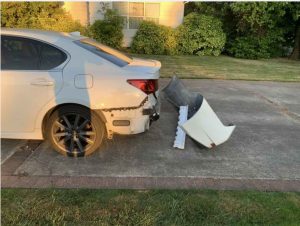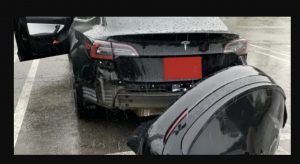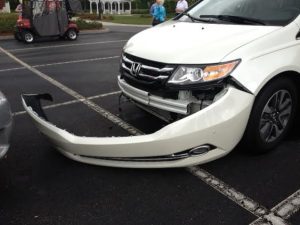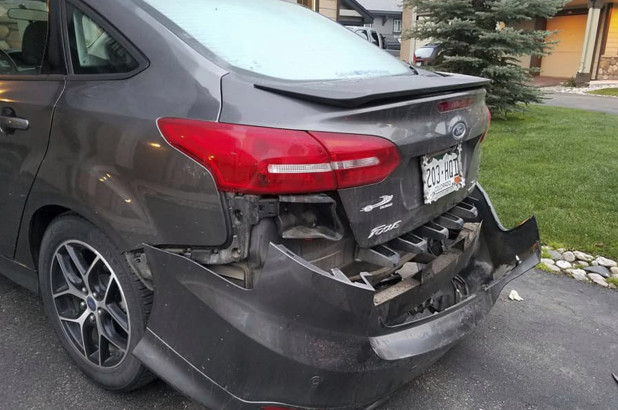The American driver is being nudged into electric cars like the Tesla and most Americans are already driving cars like the Tesla in that almost all cars made over the past roughly 25 years or so emulate the Tesla via the use of plastic extensively – and specifically, for parts of the car that, prior to about 25 years ago, were generally made of steel.
The front and rear “clips,” for instance – which are also literally that in that they clip on to the rest of the car’s body and for that reason are easily torn off the car. It is why it’s a common sight to see a car with its entire front (or rear) clip ripped away after what, in past years, would have been a minor fender-bender. One that could be easily fixed as well as an accident easily driven-away-from. But you can’t drive away from an accident that’s left you without a front or rear clip – which clips also often house the car’s plastic headlights and turn signals, among other things.
These clips are more disposable than repairable – and that brings us to the “environmentally friendly” object of this discussion.
Plastics are usually made of . . . wait for it . . . oil.
How much oil is used to make the millions of plastic front and rear clips (and other plastic parts that used to be made of things like glass, such as the modern car’s headlight assemblies, as well as the parts of the front clip that used to be made of various metals, such as the grill and no-longer-extant external bumpers) is hard to know for sure – but one can be certain it is great deal more than used to be used when plastic wasn’t used for these parts of the car.
It is likely in the millions of barrels – extracted, refined and used for this purpose rather than the purpose of propelling the car.
Ironically, new cars use plastic in lieu of metal as part of compensatory efforts to reduce the amount of oil (gasoline, refined from oil) used by cars made heavier – via “safety” decrees – by the same government that is nudging Americans into plasticized and electric cars for the sake of “the environment.”
These heavier cars also convey more kinetic energy when they hit something – like the clip-on front or rear clip of another modern plasticized car, resulting in more damage and a higher probability that the entire clip will have to be replaced with a new one, thereby doubling the quantity of plastic that had to be manufactured for that car, thereby causing more oil to be used and – presumably – more “greenhouse gasses” to be emitted during the course of all the extracting, refining, manufacturing, transporting and so on that goes into each front and rear clip.
Which must also be painted, it bears adding.
And then repainted, when the clip is replaced.
Paint generally entails the use of oil (even if water based) and the process of applying it requires energy, most of which probably does not come from solar panels. Just as more oil (and energy) is used to make car exteriors that are now a third or more made of plastic, it also takes more paint to paint a car that is entirely painted.
Prior to the ’90s, most cars were not entirely painted. They had exposed metal bumpers – which could be bumped without being ruined and so not requiring replacement. Or respraying.
A scuffed bumper could be polished back. You cannot polish a torn piece of plastic. You replace it and then you must respray it – to match the rest of the car. Think of the millions of gallons of paint that have been sprayed above and beyond what was formerly necessary and all of the “excessive emissions” produced along the way, as to power the compressors that run the paint sprayers, etc.
But there is an even larger “environmental” problem – assuming one actually cares about the environment, as opposed to using it as a pretense for imposing something else in its name.
It is the heightened disposability of the plasticized car itself, which is a function of the fragility of the plasticized car and the ratio of the cost to replace its fragile plastic panels – which remains high – vs. the value of the plasticized car itself, which depreciates with each passing year.
People who’ve been in relatively minor accidents in a plasticized car that’s eight or nine years old will be familiar with this already. Get hit from behind, get pushed into the car ahead; both clips and all the associated plastic may need to be replaced (and resprayed) plus whatever other damage was done to the car. The cost to replace even one clip can exceed $2,000 and if the car is only worth $5,000 you’re pushing the limit of what the insurance company will agree to spend to repair it.
If it exceeds it, the car – fundamentally still viable in terms of its function – gets thrown away, possibly years of useful life remaining – to be replaced by another (possibly new) car, with all of the associated “emissions” and Earth-rape the “environmentalists” – as they feign themselves – are supposedly appalled by.
It is almost certainly the case that a steel-bodied, metal-bumpered car that can take a minor impact without suffering major damage is more actually friendly toward the environment than a plasticized, disposable modern car.
But being “concerned” about that assumes “the environment” is truly the object of the “concern” – when in fact it just another excuse to make life more expensive and difficult for the average person, while guilting him into believing the burden he bears is necessary and never to be questioned.
. . .
Got a question about cars, Libertarian politics – or anything else? Click on the “ask Eric” link and send ’em in!
If you like what you’ve found here please consider supporting EPautos.
We depend on you to keep the wheels turning!
Our donate button is here.
If you prefer not to use PayPal, our mailing address is:
EPautos
721 Hummingbird Lane SE
Copper Hill, VA 24079
PS: Get an EPautos magnet or sticker or coaster in return for a $20 or more one-time donation or a $10 or more monthly recurring donation. (Please be sure to tell us you want a magnet or sticker or coaster – and also, provide an address, so we know where to mail the thing!)
My eBook about car buying (new and used) is also available for your favorite price – free! Click here. If that fails, email me at EPeters952@yahoo.com and I will send you a copy directly!












This seems a lot like “green” energy of windmills and solar panels. After a decade they might have a ROI for the massive power used to mine, refine, fabricate, assemble. Disposal costs may eliminate that too.
https://www.politico.com/news/magazine/2021/03/26/biomass-carbon-climate-politics-477620
Remember “Save the trees!”? I do.
A couple of years ago I was rear ended by an inattentive driver while I was waiting to turn left. She was driving an SUV of some sort (don’t remember) and I was in my E250 commercial cargo van. Her vehicle was totaled with plastic everywhere and the tin-foil hood crumpled like the wrap on my last sandwich. My metal bumper had a small bend and tear in the steel.
Thank gawd I was working and not on my bike!
I had to replace one of the plastic bumper clips on an almost-new Focus when my wife backed into a light pole in a parking lot (the car has a back-up camera, by the way… some harsh words were said).
Anyway, while it didn’t totally destroy the plastic, but it punctured it and scuffed it pretty good. I asked a professional body man I am acquainted with if those are fixable, and he said they basically just replace ’em.
Of course, they need to be professionally painted to match. So I was not liking the potential cost of this — probably in the $800-1000 range — and didn’t want to file an insurance claim, as my deductible is $500.
Thankfully, I got VERY LUCKY and scored one with matching factory paint at a local junkyard for $400, and it only took an hour’s worth of my labor to swap the new one onto the car.
I considered myself “fortunate,” but had it been a 1976 car instead of a 2016 the steel bumper would have suffered little to no damage… and probably would have only been $75 to replace if it had come to that.
As a matter of fact, cars started being plasticized back in the early 1970s. I remember my grandfather’s 1974 and 1978 Cadillac Sedan De Ville’s having these plastic inserts between the bumper and the rest of the body that would crack and rot out even before the actual body would rust. If I recall, they were part of the whole 5 mph bumper system in which the bumper would compress on some kind of shocks and the inserts flex.
I also saw a sales training filmstrip on YouTube made by Chrysler comparing the Chrysler Imperial to the Cadillac DeVille and Lincoln Continental Town Car. In this video, it was noted that the Imperial still had a metal grill while the Cadillac and Lincoln had a plastic grill. Note that this was BEFORE the oil crises.
So I think the plastics trend likely started out as a way for car companies to cheap out on the construction of their cars. They didn’t care if it started falling apart after a few years — you were supposed to be buying a new car by then anyway, because planned obsolescence.
The plastic fillers covered up the inner bumper and bumper shocks. It had to be flexible urethane because the federal law was no damage at 5mph. If it were sheet steel when the bumper shocks compressed a sheet steel cover would have been permanently damaged.
Yeah, that’s it…I remember him replacing the urethane fillers quite early in the car’s life.
I think Rolls-Royce is the only make that still uses metal for its grilles. I thought Bentley did as well, but I watched a recent review of a new model where the reviewer knocked it for having a plastic grille.
It’s obvious to any one who cares to actually think about it that “saving the environment” is not a goal, its a tool. Witness the climate change hysteria over something that might happen, while at the very same time completely ignoring the environmental destruction by the mostly unregulated chemical industry that’s been going on for decades. If “saving the environment” was the goal, then the role of these two threats would be reversed. There’s profit to be made in climate change, only added expense available in chemical pollution. I get tired of singing the same old song, but FOLLOW THE MONEY nearly always exposes truth.
And the military. The amount of fuel used by any of the offensive hardware is staggering. One F/A 18 can get through 10,000 lbs in less than one hour. B52, C5, much, much more.
One large piece of military hardware can use more fuel in a day than I could in a 5 years. Never mind that my stuff has emission controls and the military stuff does not.
Now we have new road treasures by the side of the road…front and rear clips. I suppose many had accidents elsewhere and attempted to drive a bit until the whole thing gave way. How would your auto collision avoidance system see that coming?
Another front end road treasure to be deposited.
And you can’t buy your way out of plastic bumpers either. Even very high end cars like Bentley and Rolls Royce come with cheap looking (especially when you consider its likely a 300k car) bumpers.
Hi Rich,
Yup; I was behind a Bentley recently and mentioned this – about the plastic – to my girlfriend. Here’s a $300k car that has cheap plastic front and rear clips, just like a $17k Hyundai. In the past, a Bentley would have awed with brilliant/deep-plated chrome …
$2,500 damage on the front end of my ‘12 Focus 2 weeks ago from a deer collision. Not bad enough to damage the hood and front fenders, just the plastic crap. Had the airbags went off ….. TOTALED!
Now , had I been driving my father’s old ‘77 T-Bird, just wipe off the bumper!
After returning to work from a doctor appointment, being doped, I slammed into the back of a city truck in my 2008 Saturn Astra. The airbags didn’t go off so I was able to sell it. The plastic did not take it as well. I liked that car for a runabout with the manual, of course. 11.5k for a pretty good car.,nice suspension for this pothole city. I was about to get a second for 11k flat for a daughter but she refused the proposed gift because it was not an automatic. Girls are stupid.
I would say 95% of all drivers today wouldn’t know how to drive a manual. So that in itself is a great anti-theft device. My Focus is a 5-speed manual and runs like a top and I have no desire to get another car. I was pissed off about my accident. So my car will “live” another day but that damned deer won’t.
I hope you ate the deer, at least…
It’s not exactly difficult top learn to drive a manual. I taught myself of necessity about a decade ago when graciously offered a loaner, a few years on from driving only automatics. I brushed up on it again late last year just because I found a deal on a cheap runabout.
It was no harder than learning to operate a forklift, and hordes of entry-level mooks in retail learn those over a few hours’ time. I’m not sure why people are so easily put off by the notion of having to manage shifts themselves. Honestly, going from power windows to crank windows is more annoying, and that’s still not a big deal.
Maybe if you were contemplating learning to drive for the first time, in a manual, with full 4WD (that second stick has to screw with a newbie), in heavy city traffic, *then* I could understand feeling overwhelmed, but learning to shift a basic FWD car after already knowing how to drive… Meh.
I’d put up with a fair bit for a *gifted* car, personally, barring a true white elephant.
Hi Mike!
Especially with modern manual-equipped cars, which have hydraulically assisted clutches. An old muscle car with a heavy clutch can be a hairy beast to deal with if you’re not already an adept!
Eric,
Is this also due to “safety” regulations? Because “The cost to replace even one clip can exceed $2,000″… What in the Christ?!
If I were to design a car, it might have wide spring-assisted bumpers surrounding the entire vehicle. Would that not comply with these absurd regulations?
I’m certainly happy I don’t own a newer car, and your journalism just continually reinforces the idea that I don’t want one.
There exist systems to repair bumper covers. The labor is expensive of course. However I have bought the stuff and successfully repaired bumper covers myself usually cheating the instructions in the process. Most of that cheating be such that I wouldn’t be sanding a wide area and thus could avoid respraying the bumper cover for a coin sized nick or a crack. Semi-skilled touch up work did well enough.
As is the case with most “environmentalism”, it is a case of the seen vs unseen
I had someone hit the ranger with its all metal bumpers and the truck took no damage, plastic on the other car which couldn’t have been going more than 25 mph at the time cracked. I hit a doe with my wife’s car it was $3500 in damages. I was under 35 mph when i hit with my foot on the brake slowing down. Didn’t matter. That bumper shattered like it was glass and hood and driver side quarter panel both folded slightly.
Hi Antilles,
I have a similar story that bears on this; a direct comparison of plasticized vs. not. I used to own a ’98 Frontier, essentially the same truck as my current ’02 Frontier except that the ’98 had a metal bumper in front while the ’02 has a plastic clip-on front end (and plastic headlights). I hit a deer with both trucks, a common occurrence here. The ’98 took slight damage; I used a come-along and a tree to pull the bumper back into place and had to replace one $25 sealed beam headlight. When the ’02 hit a deer in the same general place, it tore off the front clip and destroyed a $150 (from Nissan) headlight “assembly.” I was able to get a cheaper aftermarket knock-off and found a used “clip” at the salvage yard but had I filed a claim, the cost to repair would likely have been around $3,000.
There is still a steel bumper under the plastic cover. It’s usually of a hard/strong sheet steel tube construction. Ugly but weight and price effective. Also no plating process to run afoul of uncle’s environmental demands. the plastic cover hides the ugly.
The original front steel bumper that was on my ’97 Mustang was bent in a collision. I still have it in the garage somewhere. I could try to straighten it but it would likely crack because of hard steel. It of course was replaced when the car was repaired. I kept it in case I ever needed that sort of steel to use for a repair.
Anyway if we had metal bumpers that could meet all the requirements and didn’t have adverse weight and cost showing every car would look like it was from the set of mad max. Maybe we could get something that looked better but it would be like those ugly big-bumpered 1970s cars except the bumpers would be painted body color.
Hit a deer a “low” speed in my truck. $700 in damage.
Took the payment and put it toward a metal bumper.
Happened to know someone with one of these bumpers on a Ram 2500. Totaled a CRV and took some scratches and a dent on the bumper.
http://www.7tint.com/wp-content/uploads/2015/12/Crude@7tint.png
Take a look at that graphic. The plastics industry uses part of the “other” amount, about 7% of production. IIRC there’s also natural gas used for production of plastics. 19% goes toward transportation fuels (Jet-A, gasoline and diesel). Bunker fuel is about 1.8%. By using less gasoline there’s less oil produced. Oil drilling just for plastics is going to make finished goods far more expensive, especially if the installed infrastructure begins to be abandoned because there’s not enough demand. So that cheap, disposable crap you buy today will become a valuable trinket. Maybe plastics from plant matter will reach parity, and that way we can have food storage containers but nothing to put in them.
Same thing will be true for jet-A and bunker fuel. So your Caribbean cruise will be more expensive, along with the Southwest flight that got you to the Port of Miami. If that barrel of oil’s equation changes enough you might not be able to afford the cruise at all.
HOW ABOUT A PLASTIC CAR? Lotus Elite, Weight 1,484 pounds.
https://www.hemmings.com/stories/article/1957-63-lotus-elite
Ah one of my all-time favorites. Coventry Climax FWE engine, all aluminium, OHC, high-rev screamer, and a drop-dead gorgeous body. It is said Mazda was inspired by the Elite in styling the Miata. Too bad most Elites had serious structural issues from the unique Chapman-engineered stressed plastic body.
Another Plastic Fantastic, the Pontiac Fiero!
Sorry for the Plastic Fantastic ditty. Do not forget that it was you TV that triggered me.
https://www.youtube.com/watch?v=WL7HiGD0JcQ
Yeah, I had a nice Fiero too.
And a rather fast PITA Factory Five ’65 Cobra plastic. Blown 347 and Tremec. It is still around. Loud and terrifying.
Speaking of Tremecs, I have a nice CTS-V that is scary if you have the improper shoes and hit the foot feed when the brake is called for. It can be a mess if one takes on a moderate driveway to park it. The splitter is particularly vulnerable. I do not care to be on Eric’s Best Hits in that over complicated heap. I suppose that the thing weighs in at thrice an Elite. Just think of the guys that designed the car and then the Luxury knobs got to mess with the power seats and every gee-gaw known in 2011. They should have come out with a strippo version to save 600 pounds and the maintenance issues.
Who needs A/C in Wisconsin when you have electric windows? It is just more junk that will break.
I watched Jay Leno’s ’57 Corvette plastic car tube show. That is the best looking plastic Chevy of all time.
Heck, I’ll even take an Aztec.
The comedy movies of the 1920’s and 1930’s showed some pretty hard crashes of the cars that all had spring bumpers. They were good for considerably more than the five MPH crap from the government edicts. Heck, it was an object of fun when the bumpers latched and the drivers got out to disentangle them by jumping on the cars at the right point to disengage. No insurance adjuster ever appeared in the films.
Too bad that we cannot buy a Model A or Chevrolet with an updated drive train.
Heck, the French made a car with papier mache body panels so that they could be repaired by the owner.
You could probably build your own from parts that are available.
Yep. You can buy all the parts for a number of older cars, some are even licensed by Ford or whoever. You can even choose authentic or modern style suspension when you buy the chassis.
I had an idea that involved getting a modern crate engine & transmission, and putting them in a 1930s Ford coupe body. A few years ago i estimated it would cost about $40000 to get exactly what I wanted.
Maybe someday. But there’s a lot of time & work involved, especially if you want the end result to look good.